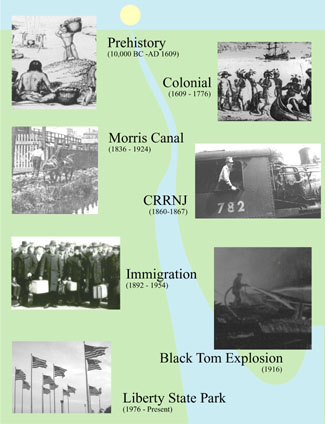Use this historic guide to travel through time!

Or use the following links:
back to top |
For nearly 9,000 years, the area now known as Liberty State Park was a quiet cove. Communipaw Cove, as the natives and early settlers called this site, was known for its oyster beds and good fishing. When Henry Hudson first explored this area in 1609, he described the location as offering safe harborage.
Throughout the Colonial Period and into the 19th century, little changed in the area. The cove was surrounded by settlements of various sizes – to the north was Bergen (now Jersey City), to the west Communipaw (now a section of Jersey City), and to the south was Caven Point. In 1661, the first chartered ferry was established near the current location of the Liberty Science Center, connecting these settlements with the larger one at the tip of Manhattan.
The 19th century witnessed a second American Revolution – the Industrial Revolution. New Jersey once again played a major role in this movement.
Transportation was the key to this period. Raw materials had to get to the factories and finished products had to get to markets. The once quiet Communipaw Cove soon evolved into a major transportation hub to fulfill this need. First to arrive in this area was the Morris Canal in 1836. The canal connected the Delaware River at Phillipsburg, NJ to the New York Harbor.
Soon the railroads saw the need to reach the markets offered via the Jersey City Waterfront. After getting permission, the Central Railroad of New Jersey (CRRNJ) purchased and began filling Communipaw Cove. Between 1860 and 1928, as the need to expand their facility grew, they continued filling the cove. At its peak, the area of the park was crisscrossed by nearly 100 miles of railroad tracks and surrounded by a web of docks and piers. The site was a virtual beehive of activity with hundreds of trains, ferries, barges and tugboats, and a variety of other water and land crafts arriving and departing daily.
The end of “The Age of the Railroad” was in sight, however, and the industry, which had peaked by 1929, rapidly declined. Better highways, competition from the trucking industry, and the shift from coal to oil and gas led to the demise of the railroads. Finally in 1967, the Aldene Plan called for the rerouting of all train traffic to Pennsylvania Station in Newark. The CRRNJ declared bankruptcy and the Terminal ceased passenger operations in April 1967.
Through the efforts of local advocates, the deserted rail yard was transformed into New Jersey’s first and largest urban park, opening to the public in 1976. The park has become an oasis in the heart of one of the most densely populated areas of the country. It is a haven for local residents and wary travelers, human as well as a wide variety of birds, fish, and other small animals.
For more information on the historic highlights of the area, please visit the historic timeline.
back to top
|